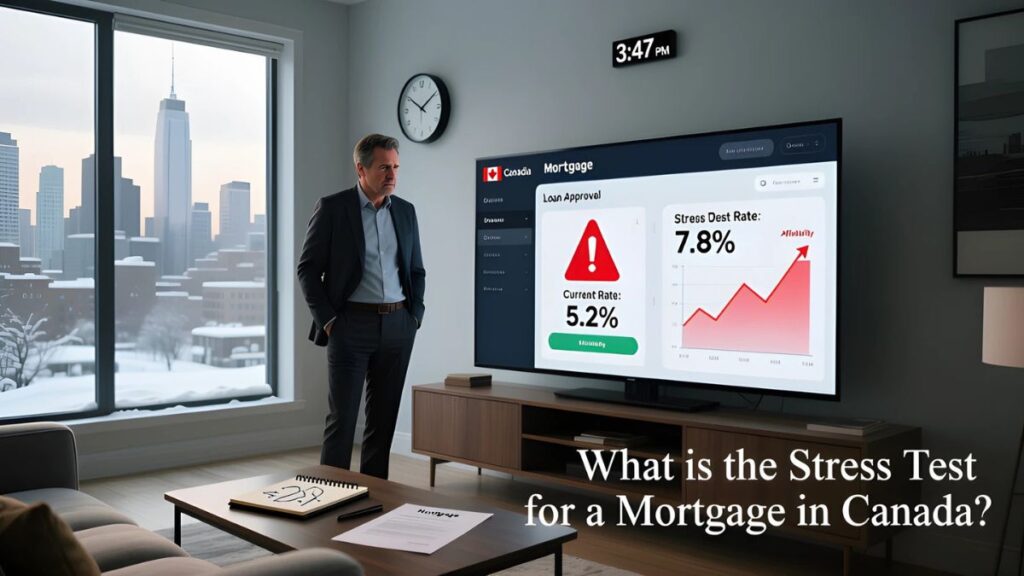Buying a home in Canada is one of the biggest financial decisions you will ever make. It is exciting, but also stressful, and today it is harder than ever for many people.
Prices are high, interest rates have risen, and saving a down payment takes years. On top of that, every buyer has to deal with something called the mortgage stress test.
Many first-time buyers ask, what is the stress test for a mortgage in Canada and why does it matter so much?
This test is often misunderstood. Some buyers see it as a frustrating rule that blocks them from borrowing what they think they can handle.
Others see it as a smart safeguard that prevents people from buying more home than they can afford.
No matter where you stand, the fact is clear: if you want a mortgage from a Canadian bank or most major lenders, you must pass it.
This guide is your complete handbook to the mortgage stress test in 2025. We will cover everything you need to know: what it is, how it works, why it was introduced, and how it affects you.
We will dive into real numbers, build tables that compare different incomes and cities, look at family budgets, and explore strategies to improve your chances.
Along the way, we will also clear up myths and answer the questions most buyers ask. By the end, you will not only understand the test, you will know how to plan for it and how to use it as part of your home-buying strategy.
What is the stress test for a mortgage in Canada?
The mortgage stress test is a financial rule that checks whether you could still afford your mortgage if interest rates rose significantly above your actual contract rate.
It is not about what you pay today. It is about whether your income can handle a “worst case” scenario in the future.
Here is the basic formula
You must qualify at the higher of:
The Bank of Canada’s minimum qualifying rate (currently 5.25%), or
Your actual mortgage rate plus 2%.
This means if your lender offers you a rate of 4.9%, the qualifying rate is 5.25%. If they offer you 6.3%, the qualifying rate jumps to 8.3%.
It does not matter if rates never rise that high. For approval purposes, the lender must use that higher figure to calculate your ability to pay.
Why Do We Have the Stress Test?
The stress test was introduced because Canadian regulators were worried about several things.
High household debt
Canadians carry some of the highest household debt in the world compared to income. Mortgages are the largest portion of that debt.
Rapidly rising home prices
In cities like Toronto and Vancouver, people were qualifying for very large mortgages that left almost no financial cushion.
Banking stability
If too many people defaulted on mortgages after rates rose, banks would face big risks. Regulators wanted to protect both borrowers and the financial system.
The stress test forces buyers to stay within more conservative borrowing limits. In practice, it reduces the size of mortgage you can qualify for by about 15% to 25% compared to using your actual rate.
A Short History of the Stress Test
Understanding where the test came from helps explain why it looks the way it does today.
2016
The first version applied only to insured mortgages (less than 20% down payment). The qualifying rate was set by the Bank of Canada.
2018
The test was expanded to all mortgages, including uninsured ones (20% or more down). This was the big change that caught many buyers off guard.
2021
OSFI raised the minimum qualifying rate to 5.25% as a permanent floor. This meant that even when actual mortgage rates were very low (like 1.8%–2.5% during 2020–2021), buyers still had to qualify at over 5%.
2022–2023
As the Bank of Canada raised interest rates to fight inflation, actual contract rates climbed to 5% and higher. The stress test became even tougher, since many borrowers were now qualifying at 7%–8%.
2025
The floor remains 5.25%, but with contract rates around 5.5%–6.5%, many buyers are still qualifying at 7.5%–8.5%.
The result is that in 2025, the stress test continues to limit affordability more than at any point in its history.
Who Has to Pass the Stress Test?
The short answer: almost everyone.
First-time buyers. Always tested.
Buyers with less than 20% down. Tested because they need insured mortgages.
Buyers with more than 20% down. Tested because uninsured mortgages are also covered.
Refinancers. Tested if you want to borrow more from your home equity.
Renewals. If you stay with your current lender, you are usually not retested. If you switch to a new lender, you are.
Unless you are simply renewing with the same bank, the test applies to you.
Must Check: HELOC vs Mortgage
How Lenders Apply the Stress Test
There are two key parts to how lenders check you: the qualifying rate and the debt service ratios.
Step 1: Set the Qualifying Rate
- Use 5.25% OR
- Use contract rate + 2%
- Pick the higher of the two.
Step 2: Calculate Debt Ratios
Gross Debt Service (GDS)
This is the percentage of your income that would go toward housing costs (mortgage, property taxes, heating, half of condo fees). The usual maximum is 39%.
Total Debt Service (TDS)
This is the percentage of your income that would go toward all debts combined (housing plus credit cards, loans, lines of credit). The usual maximum is 44%.
Worked Example
At 7.3%, the mortgage payment is about $3,500 monthly.
GDS = (3,500 + 300 + 150) ÷ 7,500 = 64% → too high
TDS = (3,500 + 300 + 150 + 400) ÷ 7,500 = 69% → too high
This household would fail the stress test. To qualify, they would need to:
Reduce their mortgage size (buy a cheaper home).
Eliminate or reduce the car loan.
Increase household income.
How the Stress Test Reduces Buying Power?
The most direct impact of the stress test is that it reduces the maximum mortgage you can get. Here is a simplified example for a household with $100,000 income, no other debts, 20% down.
| Tested Rate | Max Mortgage | Max Home Price (with 20% down) |
| 5% | $525,000 | $656,000 |
| 6% | $480,000 | $600,000 |
| 7% | $430,000 | $537,000 |
| 8% | $390,000 | $487,000 |
That difference is huge. At 5%, they could afford a $650,000 home. At 8%, they drop to under $500,000.
City-by-City Affordability Under the Stress Test
To make this more real, let’s compare incomes and average prices across Canadian cities.
Scenario: Household income $100,000, 20% down, no debts
| City | Avg home price 2025 | Max approval at 5.5% | Max approval at 7.5% | Gap |
| Toronto | $1,050,000 | $520,000 | $430,000 | -$620k |
| Vancouver | $1,200,000 | $520,000 | $430,000 | -$770k |
| Calgary | $550,000 | $520,000 | $430,000 | Close |
| Halifax | $480,000 | $520,000 | $430,000 | Possible |
| Winnipeg | $410,000 | $520,000 | $430,000 | Affordable |
This table shows why so many buyers are moving to Calgary, Halifax, and smaller cities. The stress test makes it almost impossible to buy in Toronto or Vancouver without help from family or much higher incomes.
Case Studies
Real numbers tell the real story. These case studies show how the stress test affects different buyers in everyday situations.
Case 1: Single Buyer, $80,000 Income
Average condo in Toronto = $700,000 → Out of reach
Average condo in Calgary = $320,000 → Affordable
Case 2: Couple, $140,000 Income
In Vancouver = Not enough for detached, maybe small condo
In Halifax = Enough for detached home
Case 3: Family, $160,000 Income, Two Kids
In Toronto = Far below average
In Winnipeg = More than enough for large family home
Sample Monthly Budgets
The stress test numbers do not always show the full picture. Let’s look at how budgets feel in real life.
Toronto Family Example
Total fixed costs = $7,500 → Entire income gone.
This is why the test blocks them at that level. Even though they technically pass, real life would be impossible.
Calgary Family Example
Same family in Calgary, same income, buying $530,000 home:
Total fixed costs = $7,000 → Still tight, but possible.
Lower housing costs make it feasible.
Strategies to Improve Your Chances
Want to improve your odds of passing the stress test and win the home you want? Start with these practical steps.
Pay down debt before applying
Even small balances, like car loans or credit card debt, lower the amount lenders will approve. Reducing debt raises your qualifying power.
Save a bigger down payment
A larger down payment lowers your mortgage size and makes it easier to meet the tested payments.
Add a co-signer or co-borrower with stable income
A reliable second income can increase the total income lenders consider and improve your qualifying ratios.
Use a longer amortization
Spreading payments over 30 years lowers monthly costs and can help you meet GDS and TDS limits.
Document all income thoroughly
Rental income, bonuses, overtime, and self-employment earnings can count if you provide clear paperwork, tax returns, and supporting statements.
Work with a broker
Brokers shop multiple lenders and may find ones with slightly more flexible interpretations of income, amortization, or qualifying rules.
Must Check: HELOC vs Refinancing vs Mortgage
Myths About the Stress Test
Heard conflicting stories about the stress test? Let’s bust the biggest myths so you go into the market with facts, not fear.
Myth 1: The stress test raises your rate
Not true. You only pay the contract rate your lender offers. The stress test uses a higher rate to check affordability, but it does not change the interest rate you actually pay.
Myth 2: It only applies to first-time buyers
Not true. It applies to most borrowers who need mortgage insurance and many who do not. Most people who borrow from a major lender will be assessed.
Myth 3: You can avoid it with a large down payment
Not true. Even uninsured mortgages are subject to testing by many lenders. A larger down payment helps, but it does not automatically remove the test.
Myth 4: If you fail, you can never buy
Not true. Failing the test is a signal to adjust plans. You might change timing, pay down debt, increase your down payment, or consider a different location or property type.
Remember: The stress test is a checkpoint, not the final word. It helps you avoid taking on more mortgage than you can realistically afford.
Interaction with First-Time Buyer Programs
Many first-time buyers use the mortgage stress test together with government programs to make a purchase more affordable. These programs do not remove the stress test, but they can change the math in helpful ways.
RRSP Home Buyers’ Plan (HBP)
What it does: lets eligible first-time buyers withdraw up to $60,000 from an RRSP for a down payment.
How it helps: a larger down payment lowers the mortgage amount, which makes the stress test easier to pass and reduces monthly payments.
What to watch for: you must repay the withdrawal to your RRSP over 15 years. Missing repayments can create a tax bill. The HBP moves retirement savings into your home, so weigh short-term benefit against long-term retirement impact.
First-Time Home Buyer Incentive
What it does: the government takes a shared equity stake in the home so you need a smaller mortgage.
How it helps: with a smaller mortgage you may pass the stress test more easily and have lower monthly payments.
What to watch for: it is not a loan in the usual sense. You will have to repay the government share when you sell or after a set period, based on the home’s value at that time. That can cut future gains or increase cost if the home value rises.
Tax credits and rebates
What they are: there are one-time federal and sometimes provincial tax credits or land transfer tax rebates for first-time buyers.
How they help: they are usually small but useful for covering closing costs or moving expenses.
What to watch for: these are not large enough to replace a down payment but they do reduce out-of-pocket closing costs.
How these programs interact with the stress test
The stress test still applies to any mortgage you take. Programs that lower the mortgage amount or increase your down payment make it easier to meet the test.
Some programs change the repayment picture over time, so lenders will want to see how those obligations affect your ability to pay. Be sure lenders know about HBP repayments or any incentive terms.
Quick practical tips
Compare the net benefit of each program against other options, like a larger private down payment or a different mortgage term.
Add program effects into your affordability run through. Do not treat them as bonus extra money without consequences.
Get written confirmation from lenders about how an HBP withdrawal or an incentive will affect your qualification.
Talk to a tax advisor about long-term retirement impact if you withdraw RRSP funds.
International Comparison of Mortgage Stress Tests
Mortgage stress tests exist in many countries. Comparing how each nation checks affordability helps put Canada’s rules in perspective.
| Country | How it works | Typical buffer / note |
|---|---|---|
| Canada | Lenders make borrowers qualify at a higher rate than the contract rate | National test; often stricter than peers |
| United States | Focuses on debt-to-income ratios and overall affordability | No single required buffer above contract |
| United Kingdom | Lenders test affordability using higher assumed rates and tighter checks | Stress testing has been used after crises |
| Australia | Lenders apply a buffer, commonly around 3% above the offered rate | Regulators encourage conservative lending |
| New Zealand | Similar to Australia, borrowers are assessed at higher rates than contracted | Common practice to assume a margin above rate |
Frequently Asked Questions
Can I shop around different lenders to avoid the test?
Do credit unions apply the test?
Does the test change if I choose variable versus fixed rate?
What if rates drop again?
Final Checklist for Buyers
Before you start house hunting, ask yourself this: what is the stress test for a mortgage in Canada going to do to your budget and your chances of getting the home you want?
Know your tested rate before you shop
Find out the rate lenders will use to test you so you understand your true borrowing limit.
Run your own numbers with GDS and TDS
Calculate your Gross Debt Service and Total Debt Service ratios to see what monthly payments you can afford.
Pay off debts early
Reduce or eliminate credit card balances, personal loans, and lines of credit to improve your qualifying ratios.
Save as much down payment as you can
A larger down payment lowers your mortgage size and makes passing the stress test easier.
Use first-time buyer programs if eligible
Check programs like the Home Buyers’ Plan and land transfer tax rebates to reduce upfront costs.
Consider location flexibility
Broaden your search to neighborhoods or nearby cities where prices are more affordable and your chances of qualifying improve.
Conclusion
The mortgage stress test is tough by design. It lowers how much you can borrow so you are less likely to be hit by rate hikes or unexpected financial shocks. That means buying power is smaller, especially in expensive markets, but it also helps protect your long-term finances.
With careful budgeting, realistic expectations, and the right plan, you can still buy a home that fits your life. Prepare, run the numbers, and explore options like different terms or lenders.
Need help?
AJP Mortgage can walk you through the stress test, run affordability scenarios, and show practical paths to buying a home you can afford. Contact AJP Mortgage to get started..


